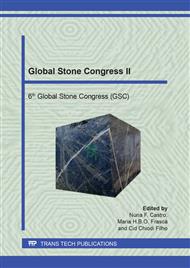p.3
p.10
p.20
p.28
p.35
p.48
p.58
p.66
Application of Castor Oil Based Polyurethane Resin in the Dimension Stone Block Wrapping Process
Abstract:
The dimension stone wrapping process is a method used before the sawing of the block which aims to enhance the integrity of the rock, thus ensuring that fractured or altered blocks remain intact while they are handling and splitting into slabs. This method increases safety and allows the processing of many materials once not commercialized. Nevertheless, the epoxy resin used in the process comes from a non-renewable resource and contains toxic substances on its composition. Therefore, in order to increase the eco-efficiency in the sector of dimension stones, a comparison of the epoxy resin with an ecological and non-toxic resin based on the castor oil, was carried out aiming to know the resulting tensile strength in the contact of the polymer with the stone surface. Two types of rocks were tested, a silicate and a carbonate one. The results indicated that the castor oil resin performed a higher tensile strength regarding carbonate rocks, suggesting that the castor oil resin could replace the epoxy resin when applied to this rock group, providing an environmental advantage and a global marketing differential.
Info:
Periodical:
Pages:
20-27
Citation:
Online since:
June 2020
Keywords:
Price:
Сopyright:
© 2020 Trans Tech Publications Ltd. All Rights Reserved
Share:
Citation:


